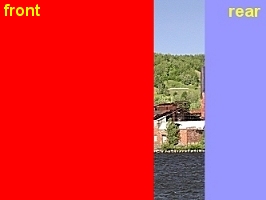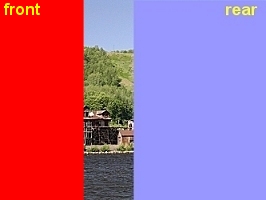Before we learn why there is something called synchronization shutter speed, we need to know a little more about traditional shutters. There are at least two types of shutters, leaf shutters and curtain shutters. The former is built into a lens and is very popular in rangefinders. On the other hand, the latter is a universal mechanism in SLR and DSLR cameras. Therefore, we will use curtain shutter exclusively on this page.
Every curtain shutter has two "curtains" covering the film plane. These curtains either move horizontally or vertically in the same direction. The left image below should an example of Nikon F3. The film (and the shutter) is being rewound and the lead of the second curtain is moved to the middle of the frame. These two curtains move horizontally. The right image below shows Nikon F5's curtains that move vertically.

|

|
The following diagram shows the scheme we shall use. When the shutter release button is pressed fully to take a photo, the front (or first) curtain moves. After a very brief moment that depends on the chosen shutter speed, the rear (or second) curtain starts to move (in the same direction, of course).

Suppose we wish to take the image shown in (a) below. Initially, the front curtain covers the film as in (b). Right after the shutter release button is pressed to take this photo, the front curtain (in red) starts to move to the left, and then the rear curtain (in light blue) moves. This creates a gap that exposes the film to the incoming light as shown in (c). Since the movement of the curtains is of constant speed, once this gap appears, it moves to the left in constant speed as shown in (d). Eventually, the front curtain reaches the left end, followed by the rear one. Then, the film is covered completely again by the rear curtain as shown in (e). Since the gap moves from right to left in constant speed, every place on the film will be exposed the same amount of time.

|

|

|
| (a) | (b) | (c) |

|

|
| (d) | (e) |
Of course, shutter speed is determined by the width of the gap. Why? Consider a "pixel" that is just exposed to the incoming light because the front curtain expose it to the incoming light. If it takes s second for the rear curtain to travel the width of the gap, this "pixel" will be exposed to the incoming light for s second. Hence, this is exactly the shutter speed! Therefore, the gap will be wider (resp., narrower) if the shutter speed is slower (resp., faster).
When a flash discharges, it does not reach its peak power immediately. Instead, its output starts with zero, increases to its peak, and then declines in a rate that is slower than the initial phase. The so-called effective flash duration, or flash duration, is the period between 1/3 peak power points. In other words, since the flash discharge starts and ends with zero, there is a point from zero to its peak so that the output is 1/3 of the peak. Similarly, there is a second point from the peak down to zero so that the output is also 1/3 of the peak. The difference between these two points is the flash duration. Of course, during this flash duration, we have at least 2/3 power to use. However, the flash discharge still illuminates the scene outside of this duration! Note that weaker output implies shorter flash duration. This is the way of controlling flash discharge power. The following shows some flash duration examples:
| SB30 | SB50DX | SB80DX |
| 1/2800 sec (full power) | 1/1800 sec (full power) | 1/1050 sec (full power ) |
| 1/41600 sec (1/128 power) |
Now, we can talk about synchronization speed. As discussed in previous sections, the gap between the front and rear curtains must be very narrow to support very short flash duration (e.g., 1/1050 sec of the SB-80DX). The problem is: when the flash discharges, it can only illuminates ONE gap, perhaps at the very right end, and on the image one can only see a properly exposed narrow stripe and the remaining portion is black. This is certainly what we do not want. What we really need is a properly illuminated full frame.
To obtain a properly exposed full frame, the flash must discharge after the front curtain reaches one end, and before the rear curtain begins to move. In this way, the whole frame will be exposed to flash illumination. Of course, the flash also needs time to complete its discharge. Therefore, a shutter speed that can expose the full frame to the incoming light plus the flash duration is needed to obtain a properly flash exposure. This shutter speed is referred to as the flash synchronization shutter speed.
Coolpix models use combined mechanical and electronic shutters. Since there is no moving curtains, Coolpix models have much faster synchronization shutter speed. Can we use any shutter speed? The answer is certainly a YES; but, if the shutter speed being used is too fast, you might not get good results. That a Coolpix can synchronize a flash at any shutter speed may be true for previous models. With 5700's 1/4000 sec shutter speed, this is not the case because 1/4000 sec is too short for the flash to reach its peak, and before the flash discharge completes, the shutter closes. As a result, a considerably under-exposed image is likely.